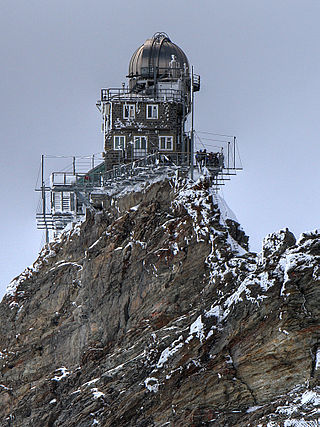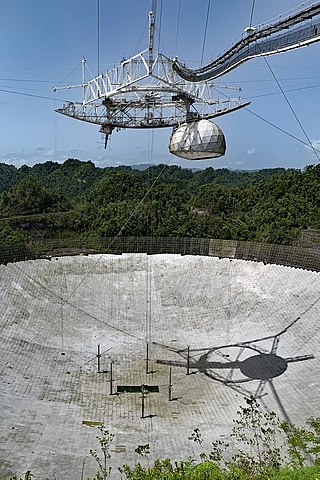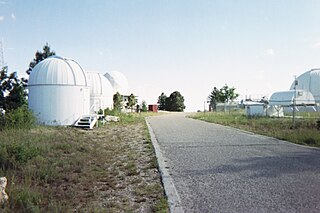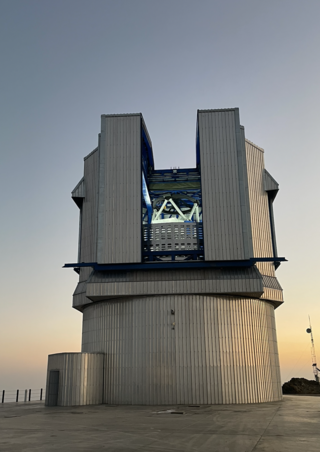
The Kitt Peak National Observatory (KPNO) is a United States astronomical observatory located on Kitt Peak of the Quinlan Mountains in the Arizona-Sonoran Desert on the Tohono Oʼodham Nation, 88 kilometers (55 mi) west-southwest of Tucson, Arizona. With more than twenty optical and two radio telescopes, it is one of the largest gatherings of astronomical instruments in the Earth's northern hemisphere.

An observatory is a location used for observing terrestrial, marine, or celestial events. Astronomy, climatology/meteorology, geophysics, oceanography and volcanology are examples of disciplines for which observatories have been constructed. Historically, observatories were as simple as containing an astronomical sextant or Stonehenge.

The Arecibo Observatory, also known as the National Astronomy and Ionosphere Center (NAIC) and formerly known as the Arecibo Ionosphere Observatory, is an observatory in Barrio Esperanza, Arecibo, Puerto Rico owned by the US National Science Foundation (NSF).

The Mount Wilson Observatory (MWO) is an astronomical observatory in Los Angeles County, California, United States. The MWO is located on Mount Wilson, a 1,740-meter (5,710-foot) peak in the San Gabriel Mountains near Pasadena, northeast of Los Angeles.

Clinton Banker Ford, aged 79, was an American investor, musician and amateur astronomer specializing in the observation of variable stars.

The CERGA Observatory was a scientific department and astronomical station of the Côte d'Azur Observatory in southern France, where several asteroids were discovered during 1984–1993.

The Center for Astrophysics | Harvard & Smithsonian (CfA), previously known as the Harvard–Smithsonian Center for Astrophysics, is an astrophysics research institute jointly operated by the Harvard College Observatory and Smithsonian Astrophysical Observatory. Founded in 1973 and headquartered in Cambridge, Massachusetts, United States, the CfA leads a broad program of research in astronomy, astrophysics, Earth and space sciences, as well as science education. The CfA either leads or participates in the development and operations of more than fifteen ground- and space-based astronomical research observatories across the electromagnetic spectrum, including the forthcoming Giant Magellan Telescope (GMT) and the Chandra X-ray Observatory, one of NASA's Great Observatories.
The Combined Array for Research in Millimeter-wave Astronomy (CARMA) was an astronomical instrument comprising 23 radio telescopes, dedicated in 2006. These telescopes formed an astronomical interferometer where all the signals are combined in a purpose-built computer to produce high-resolution astronomical images. The telescopes ceased operation in April 2015 and were relocated to the Owens Valley Radio Observatory for storage.

The MMT Observatory (MMTO) is an astronomical observatory on the site of Fred Lawrence Whipple Observatory. The Whipple observatory complex is located on Mount Hopkins, Arizona, US in the Santa Rita Mountains. The observatory is operated by the University of Arizona and the Smithsonian Institution, and has a visitor center in nearby Amado, Arizona. The MMTO is the home of the MMT, which has a primary mirror 6.5 m in diameter. The name comes from the six smaller mirrors originally used before the single primary mirror was installed in 1998. The primary mirror has a special lightweight honeycomb design made by the University of Arizona's Steward Observatory Mirror Laboratory. The MMT is housed in a building which allows the walls and roof around the telescope to be completely rolled back, allowing it to cool down very quickly in order to improve observation.
Leuschner Observatory, originally called the Students' Observatory, is an observatory jointly operated by the University of California, Berkeley and San Francisco State University. The observatory was built in 1886 on the Berkeley campus. For many years, it was directed by Armin Otto Leuschner, for whom the observatory was renamed in 1951. In 1965, it was relocated to its present home in Lafayette, California, approximately 10 miles (16 km) east of the Berkeley campus. In 2012, the physics and astronomy department of San Francisco State University became a partner.
Piera Observatory is an astronomical observatory located in Piera, Catalonia, with the IAU observatory code 165.

The Badlands Observatory (IAU code 918) is an astronomical observatory named after the Badlands National Park, located in Quinn, South Dakota, near the city of Wall, United States. The observatory was founded in 2000. by American amateur astronomer Ron Dyvig, who was associated with the Optical Sciences Center and Steward Observatory of the University of Arizona. While there, he occasionally participated in observing runs using the telescopes on Kitt Peak. Kitt Peak Observatory As of November 2016, a total of 25 numbered minor planets were discovered at the observatory. The Minor Planet Center credits these discoveries to Ron Dyvig and to the observatory, respectively. The main-belt asteroid (315495) 2008 AQ3 was discovered by Italian amateur astronomer Fabrizio Tozzi while using the Badlands Observatory telescope remotely via the Internet in 2008. Asteroid 26715 South Dakota, discovered by Ron Dyvig in 2001, is named after the U.S. state South Dakota, where the Badlands observatory is located.

Fremont Peak Observatory (FPOA) is an astronomical observatory operated by Fremont Peak Observatory Association (FPOA) under contract to the State of California. Built in 1986, it is located in Fremont Peak State Park, near San Juan Bautista, California. Fremont Peak Observatory houses the Challenger telescope.

Ashton Observatory is a public astronomical observatory operated by the Des Moines Astronomical Society, in collaboration with Jasper County, Iowa (USA). It is located in Ashton-Wildwood County Park near Baxter, Iowa. Public programs are presented on Saturday evenings in the months of April through October, except for the first Saturday of each month. These public nights were cancelled for 2020, due to the Covid-19 pandemic.

Mount Lemmon Observatory (MLO), also known as the Mount Lemmon Infrared Observatory, is an astronomical observatory located on Mount Lemmon in the Santa Catalina Mountains approximately 28 kilometers (17 mi) northeast of Tucson, Arizona (US). The site in the Coronado National Forest is used with special permission from the U.S. Forest Service by the University of Arizona's Steward Observatory, and contains a number of independently managed telescopes.

Shattuck Observatory is an astronomical observatory owned and operated by Dartmouth College in Hanover, New Hampshire, United States.

Fuertes Observatory is an astronomical observatory located on the North Campus of Cornell University in Ithaca, New York. The observatory was designed by L.P. Burnham, Cornell Professor of Architecture and completed in fall of 1917. It was originally used by the Civil Engineering Department as an instructional field office for navigation and surveying. Today, the observatory is primarily used for public outreach, welcoming over two thousand visitors per year with open houses on clear Friday nights.
The National Astronomical Observatories, Chinese Academy of Sciences(NAOC, Chinese: 中国科学院国家天文台; pinyin: Zhōngguó Kēxuéyuàn Guójiā Tiānwéntái) is an astronomical research institute operated by Chinese Academy of Sciences, along with Shanghai Astronomical Observatory, Purple Mountain Observatory and National Time Service Center.

Iranian National Observatory (INO) is an Iranian astronomical observatory inaugurated in 2021. It has reported the capture of its first light on 15 October 2022 upon the commissioning of the home-grown optical telescope with a primary mirror of 3.4 m, making it by far the country's largest astronomical research facility.















